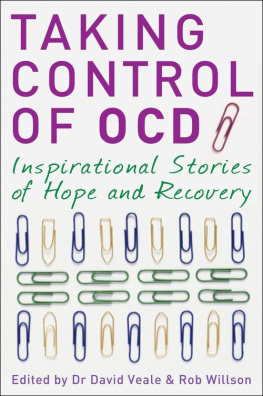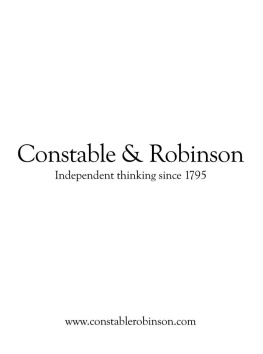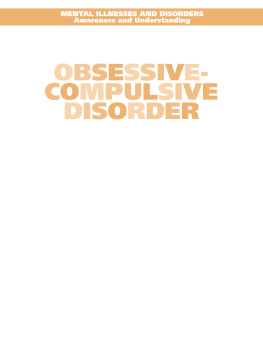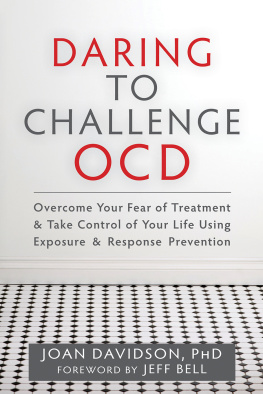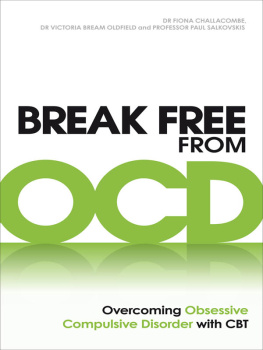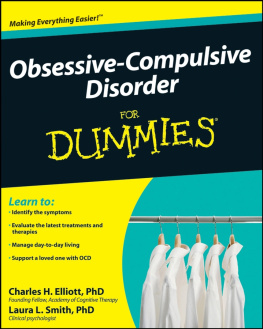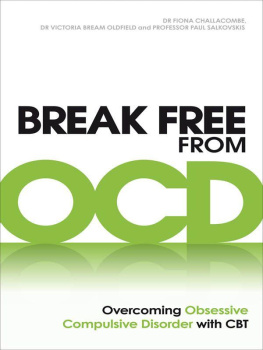This is a unique book of inspirational stories written by real people who have sought to overcome their own obsessive compulsive disorder. Wed like to extend our thanks to all of the people who have contributed to this book. We recognize that it takes courage to expose those aspects of themselves that, at one time at least, seemed the most shameful and abhorrent. OCD is a problem shrouded by shame, ignorance and pessimism. It is not uncommon for a person with OCD to suffer for ten years before they receive a diagnosis.
We hope this book will help individuals with OCD recognize that they are not alone with their problem. One of the things thats so exiting about hearing the stories of how people overcame their OCD is that it provides an opportunity to learn how they integrated a set of general treatment principles to their unique personalities. Our aim in this chapter is to briefly outline what obsessive compulsive disorder (OCD) is and how it is usually overcome. We hope this will provide a reference from which the reader can consider the courageous journeys described in this book. For a more detailed explanation of OCD and how it can be beaten, please consult our book, Overcoming Obsessive Compulsive Disorder, also published by Constable & Robinson.
OCD
OCD is the fourth most common psychological problem after depression, alcohol and substance abuse, and social phobia. Researchers estimate that about two in every hundred of the population have OCD at some time in their life. At least one in every hundred of the adult population is significantly distressed and handicapped by their OCD, and about one in every two hundred children and adolescents. The frequency is much the same all over the world, although the common forms of OCD may differ according to the culture.
In essence, OCD is a problem of trying too hard to reduce the threat of harm. The content of an obsession is usually what a person tries hard not to think about, or a kind of harm they particularly want to prevent. This might be a threat of harm to the self or other people, in the present or the future. People with OCD often feel that they have a pivotal responsibility for preventing or causing harm. This is often based on a misinterpretation that a mental event, a product of their mind such as an intrusive thought, image, doubt or impulse, is a threat in some way. For example, he or she may view themselves as bad for having such thoughts or are worried that the anxiety will make them lose control and go mad. If you are a person with OCD, you might try to rid yourselves of these mental events by carrying out a compulsion or avoiding triggers, but several consequences can occur:
- The more you check something the more responsible youll feel.
- The more you check something the more doubts youll have.
- The more you try to neutralize or suppress a thought or image the more intrusive it will become.
- The more you analyse a thought the more significant your mind will interpret that thought as being, and therefore it will be more likely to draw your attention to it.
- The more you try to reduce threats the more aware of them you will become.
- The more you try to reassure yourself or get reassurance from others, them ore your doubts return.
- The more you wash, the more likely you are to feel dirty and to wash again.
- The more you avoid something the more your fear of it will increase.
As you can see, the solution is the problem. Sometimes it feels like your solutions work briefly (for example, they reduce anxiety or make you feel more certain) but then it gets worse. Overcoming OCD therefore usually involves the person re-training their brain to take less excessive levels of responsibility, and to treat intrusive thoughts and urges as part of very normal events in their mind, that should be allowed to simply happen. It means not responding to them and allowing yourself to just experience the thoughts and feelings.
Anxiety
Another key element of OCD is anxiety. Feeling anxious will make you more likely to jump to the worst conclusion, and will make catastrophic thoughts and images seem much more plausible: you may really start to believe that terrible, life-altering things are going to happen. Therefore, thinking and acting in ways that would be consistent with not being afraid, and facing your fears, are a large part of recovering.
Other obsessional problems
There are a some other obsessional problems that share similarities to OCD, including; health anxiety, in which a person is excessively preoccupied and distressed about the idea that they have or may contract an illness (this is covered in detail in our book, Overcoming Health Anxiety, published by Constable & Robinson); body dysmorphic disorder (BDD) in which a person is excessively preoccupied with the idea that they are ugly (this is covered in detail in our book, Overcoming Body Image Problems including Body Dysmorphic Disorder). Compulsive hair-pulling (trichotillomania) and compulsive skin picking are also seen as related to OCD. All of these problems are similar in that refusing to participate in compulsions is the key to overcoming the problem.
Different kinds of OCD
Obsessive compulsive disorder can take many different forms. The various stories in this book represent most of the common ones. Below we introduce some of the different types. However, we could easily fill several volumes describing the many different variations of OCD so please dont be alarmed if what you read isnt exactly you.
The most common kind of OCD is fear of contamination. This usually involves a fear of either causing harm or being harmed by germs, viruses, chemicals or other dangerous substances. Other than harm, some people with contamination obsessions are trying to avoid disgust. This is usually from sources such as bodily fluids and faeces. Researchers have also learned that some people with mental contamination do not need to have any physical contact to feel contaminated. They may have felt betrayed or violated in the past or may now fear having their personality contaminated through association or contact with people they regard as undesirable. The most common safety strategies related to contamination fears are avoidance of something or excessive washing. Washing might be of hands or body parts, or might include washing clothes, surfaces or items such as door handles.
Another common kind of obsession is the fear of being responsible for other kinds of harm such as the home being burgled or causing fire as a consequence of not being careful enough. The main strategies that people tend to use that maintain these fears are checking and giving up responsibility to someone else. An example of this kind of OCD is a fear of accidentally running someone over, leading the person to repeatedly retrace his or her journey or excessive checking in the rear-view mirror. An important understanding from research is that the more a person checks to make sure that they have not caused harm or failed to prevent harm, the more responsible and uncertain they feel. This is why stopping checking is so often a key part of recovering from OCD.
Around 7 per cent of obsessions focus upon the body or physical symptoms. This may have some overlap with health anxiety, in which a person fears that they may have an illness or are afraid that they may contract an illness. The more common concerns are cancer and AIDS/HIV, but it can be about any kind of physical or mental illness.
Another form of OCD is excessive concern with exactness, order or symmetry, such as excessively tidying and straightening up areas of the home or office. This might include excessively well-ordered bookcases, wardrobes, drawers, desks, kitchen cupboards and so on. This can make everyday activities very time-consuming, and can sometimes lead individuals with OCD to ban other people from areas of their home.

